child seat BUICK REGAL 1997 Owners Manual
[x] Cancel search | Manufacturer: BUICK, Model Year: 1997, Model line: REGAL, Model: BUICK REGAL 1997Pages: 422, PDF Size: 21.34 MB
Page 15 of 422
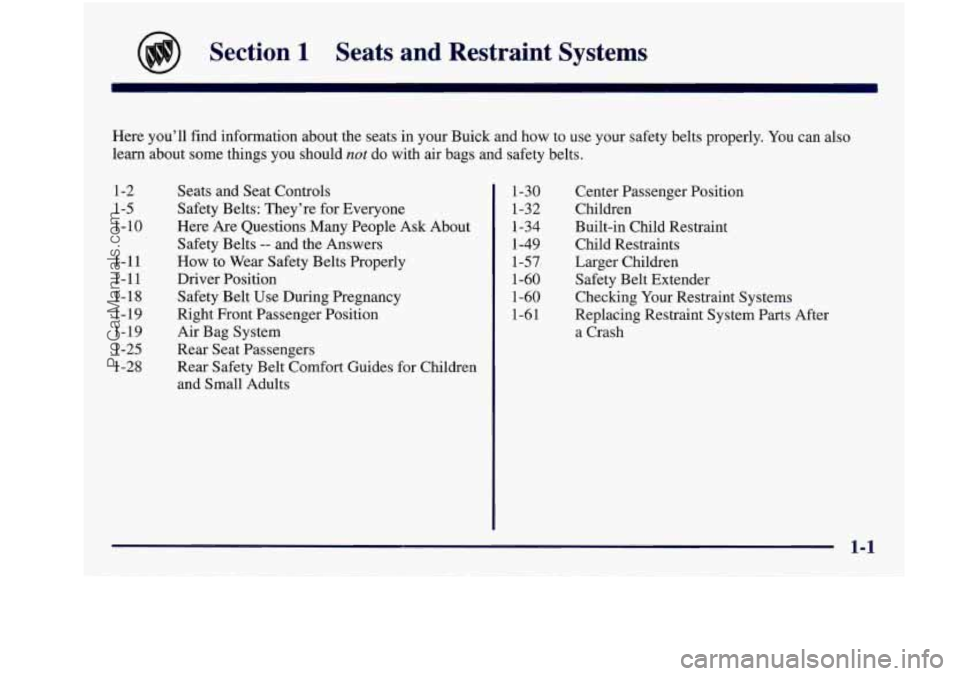
Section 1 Seats and Restraint Systems
Here you’ll find information about the seats in your Buick \
and how to use your safety belts properly. You can also
learn about some things you should
not do with air bags and safety belts.
1-2
1-5
1-10
1-11
1-11
1-18
1-19
1-19
1-25
1-28 Seats and Seat Controls
Safety Belts: They’re for Everyone
Here
Are Questions Many People Ask About
Safety Belts
-- and the Answers
How
to Wear Safety Belts Properly
Driver Position Safety Belt
Use During Pregnancy
Right Front Passenger Position
Air Bag System
Rear Seat Passengers
Rear Safety Belt Comfort Guides for Children and Small Adults 1-30
1-32
1-34
1-49
1 1-57.
~ 1-60 1-60
1-61 Center Passenger Position
Children
Built-in Child Restraint Child Restraints
Larger Children
Safety Belt Extender Checking Your Restraint Systems
Replacing Restraint System Parts After
a Crash
ProCarManuals.com
Page 25 of 422
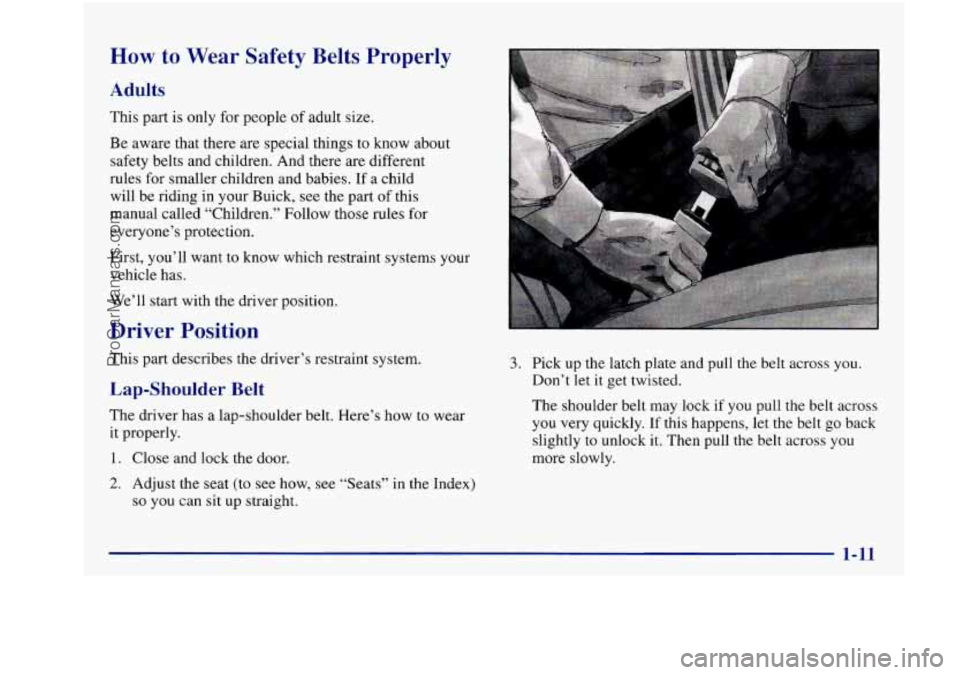
How to Wear Safety Belts Properly
Adults
This part is only for people of adult size.
Be aware that there are special things to know about
safety belts and children. And there are different
rules for smaller children and babies. If
a child
will be riding in your Buick,
see the part of this
manual called “Children.” Follow those rules for
everyone’s protection.
First, you’ll want to know which restraint systems your
vehicle has.
We’ll start with the driver position.
Driver Position
This part describes the driver’s restraint system.
Lap-Shoulder Belt
The driver has a lap-shoulder belt. Here’s how to wear
it properly.
1. Close and lock the door.
2. Adjust the seat (to see how, see “Seats” in the Index)
so you can sit up straight.
3. Pick up the latch plate and pull the belt across you.
Don’t let it get twisted.
The shoulder belt may lock if you pull the belt across
you very quickly. If this happens, let the belt go back
slightly to unlock it. Then pull the belt across you
more slowly.
1-11
ProCarManuals.com
Page 42 of 422
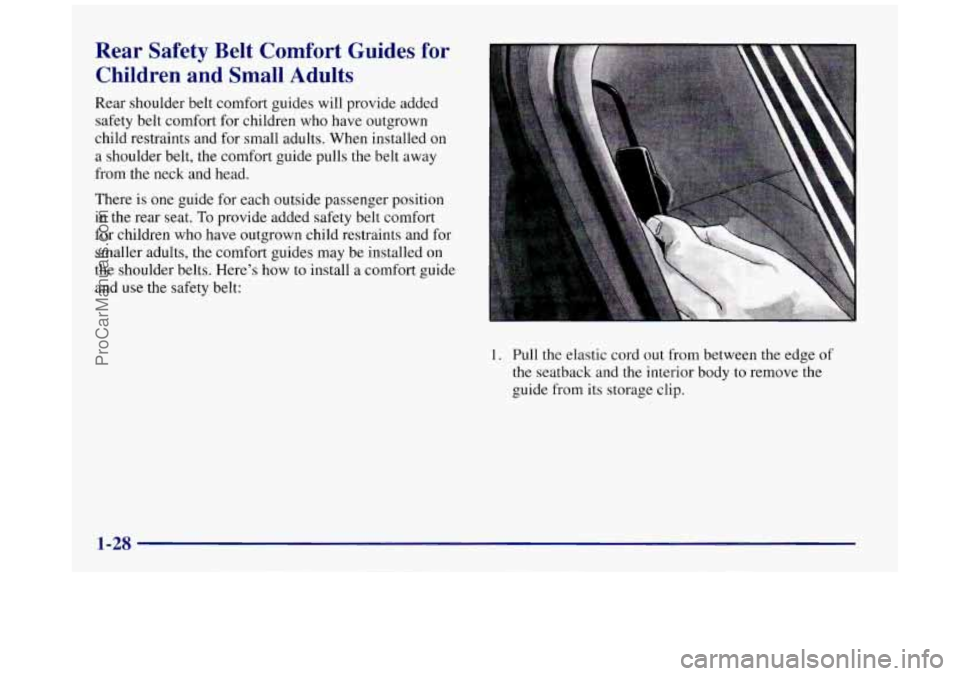
Rear Safety Belt Comfort Guides for Children and Small Adults
Rear shoulder belt comfort guides will provide added
safety belt comfort for children who have outgrown
child restraints and for small adults. When installed on
a shoulder belt, the comfort guide pulls the belt away
from the neck and head.
There is one guide for each outside passenger position
in the rear seat. To provide added safety belt comfort
for children who have outgrown child restraints and for
smaller adults, the comfort guides may be installed on
the shoulder belts. Here’s how to install a comfort guide
and use the safety belt:
1. Pull the elastic cord out from between the edge of
the seatback and
the interior body to remove the
guide from its storage clip.
1-28
ProCarManuals.com
Page 48 of 422
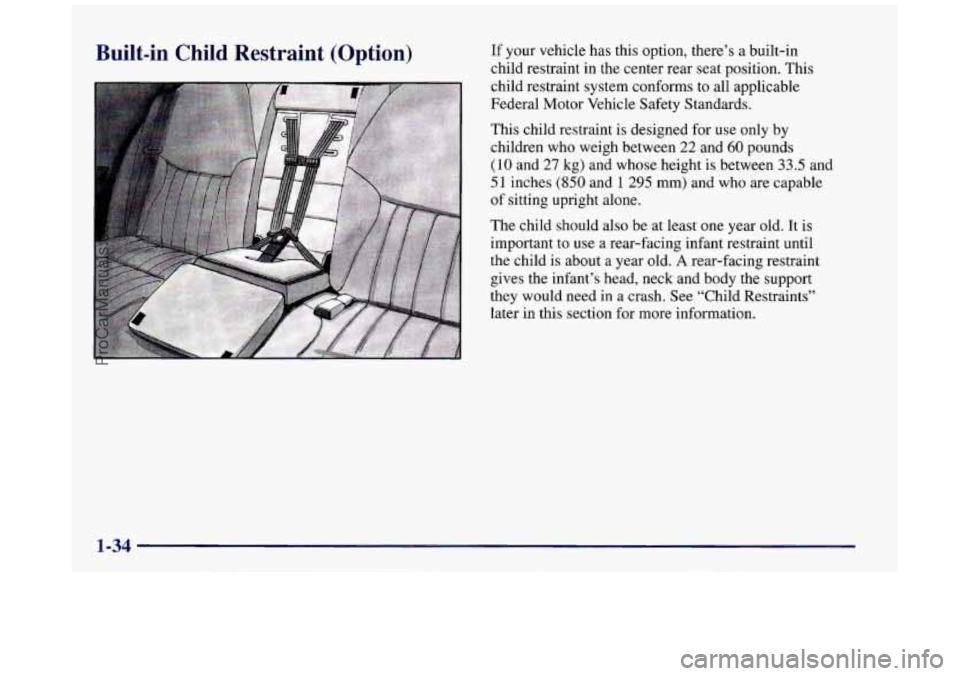
Built-in Child Restraint (Option) If your vehicle has this option, there’s a built-in
child restraint in the center rear seat position. This
child restraint system conforms to ali applicable
Federal Motor Vehicle Safety Standards.
This child restraint is designed for use only by
children who weigh between
22 and 60 pounds
(10 and 27 kg) and whose height is between 33.5 and
51 inches (850 and 1 295 mm) and who are capable
of sitting upright alone.
The child should also be at least one year old. It is
important
to use a rear-facing infant restraint until
the child is about a year old.
A rear-facing restraint
gives the infant’s head, neck and body the support
they would need in a crash. See “Child Restraints”
later in this section for more information.
ProCarManuals.com
Page 49 of 422
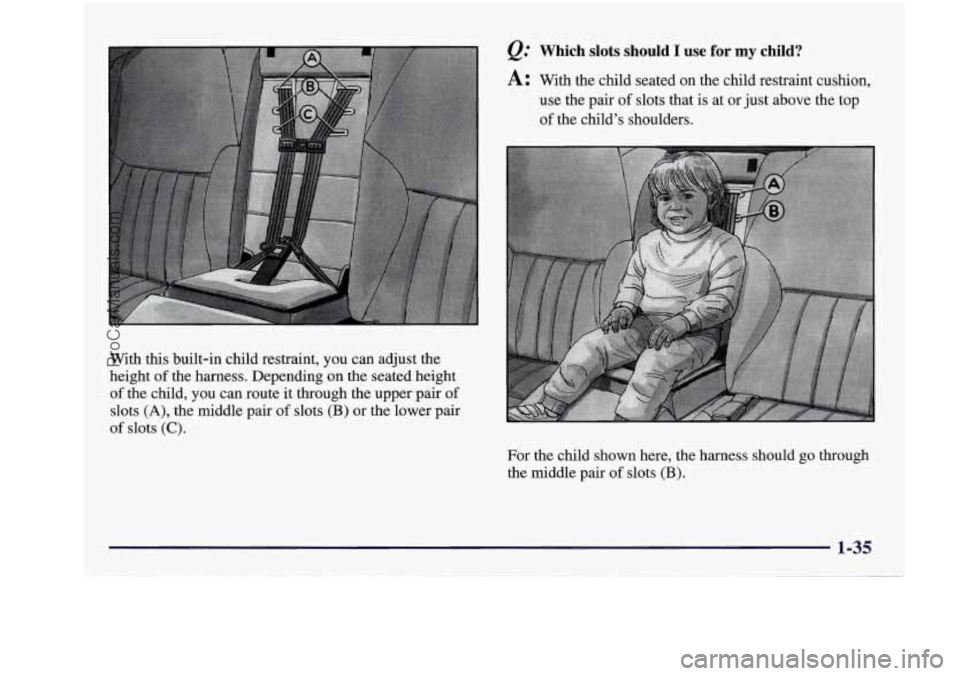
With this built-in child restraint, you can adjust the
height
of the harness. Depending on the seated height
of the child, you can route it through the upper pair of
slots (A), the middle pair of slots (B) or the lower pair
of slots (C).
&.' Which slots should I use for my child?
A: With the child seated on the child restraint cushion,
use the pair
of slots that is at or just above the top
of the child's shoulders.
For the child shown here, the harness should go through the middle pair
of slots (B).
1-35
ProCarManuals.com
Page 50 of 422

@ What if the top of my child’s shoulders is above
A: A child whose shoulders are above the highest slots
the highest pair of slots?
shouldn’t use this child restraint. Instead, the child
should sit on the vehicle’s seat cushion and use the
vehicle’s safety belts.
MAKE SURE THE TOP OF THE CHILD’S
SHOULDERS IS BELOW THE SLOTS THAT
THE HARNESS GOES THROUGH.
A CHILD
WHOSE SHOULDERS ARE ABOVE THOSE
SLOTS COULD BE
IN JURED DURING A
SUDDEN STOP OR CRASH. IF‘ THE TOP
OF THE CHILD’S SHOULDERS IS ABOVE
THE SLOTS, DON’T USE THIS CHILD
RESTRAINT. INSTEAD, THE CHILD SHOULD
SIT ON THE VEHICLE’S REGULAR SEAT
AND USE THE REGULAR SAFETY BELTS.
Adjusting the Harness Height
1. Lower the child restraint cushion.
ProCarManuals.com
Page 54 of 422
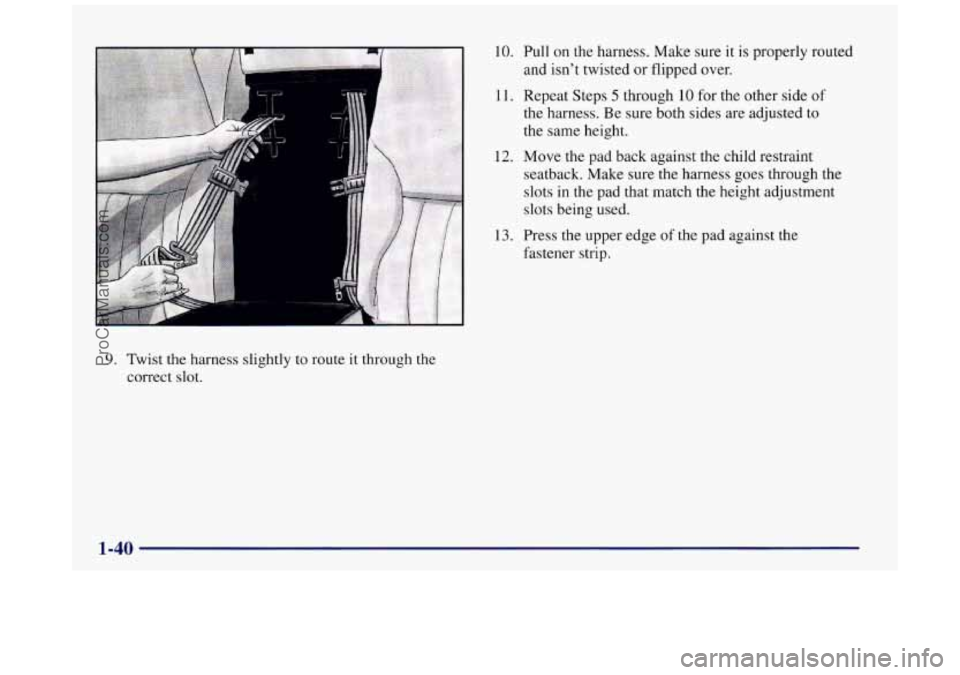
9. Twist the harness slightly to route it through the
correct
slot.
10. Pull on the harness. Make sure it is properly routed
and isn’t twisted or flipped over.
11. Repeat Steps 5 through 10 for the other side of
the harness. Be sure both sides are adjusted to
the same height.
12. Move the pad back against the child restraint
seatback. Make sure the harness
goes through the
slots in the pad that match the height adjustment
slots being used.
fastener strip.
13. Press the upper edge of the pad against the
1-40
-
ProCarManuals.com
Page 55 of 422
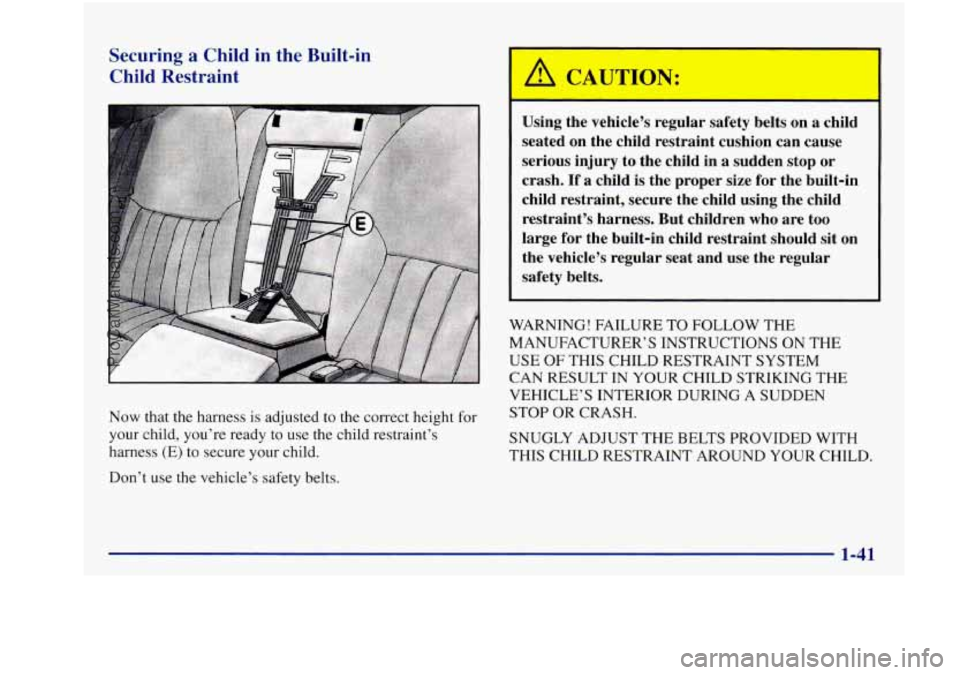
Securing a Child in the Built-in
Child Restraint
Now that the harness is adjusted to the correct height for
your child, you’re ready to use the child restraint’s
harness (E) to secure your child.
Don’t use the vehicle’s safety belts.
Using the vehicle’s regular safety belts on a child
seated on the child restraint cushion can cause
serious injury to the child in a sudden stop or
crash.
If a child is the proper size for the built-in
child restraint, secure the child using the child
restraint’s harness. But children who are too
large for the built-in child restraint should sit on
the vehicle’s regular seat and use the regular
safety belts.
WARNING! FAILURE TO FOLLOW THE
MANUFACTURER’S INSTRUCTIONS
ON THE
USE OF THIS CHILD RESTRAINT SYSTEM
CAN RESULT IN
YOUR CHILD STRIKING THE
VEHICLE’S INTERIOR DURING A SUDDEN
STOP
OR CRASH.
SNUGLY ADJUST THE BELTS PROVIDED WITH
THIS CHILD RESTRAINT AROUND YOUR CHILD.
ProCarManuals.com
Page 62 of 422
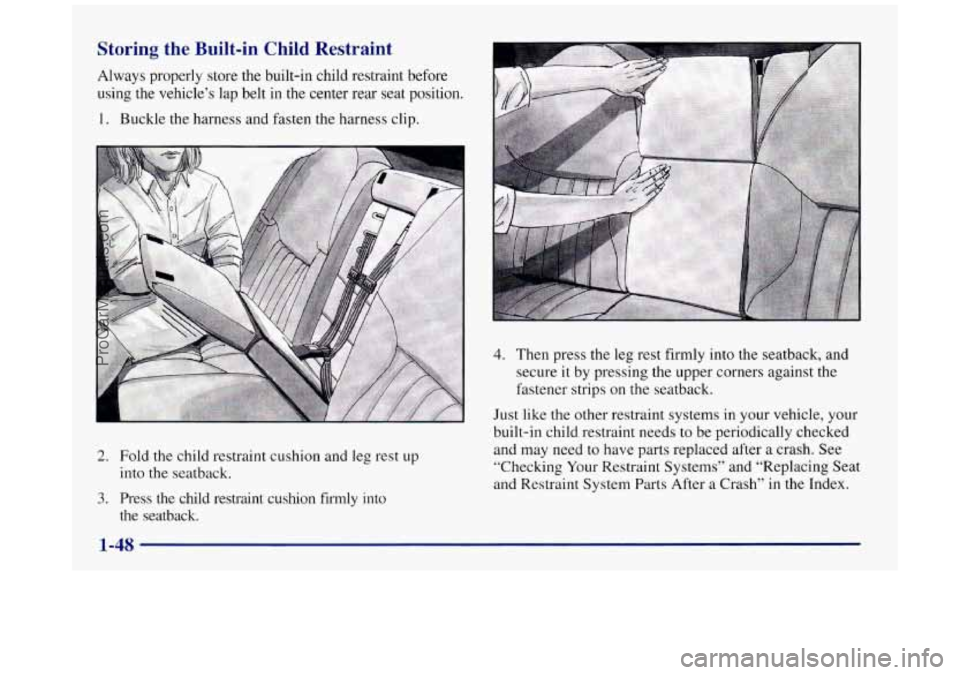
Storing the Built-in Child Restraint
Always properly store the built-in child restraint before
using the vehicle’s lap belt in the center rear seat position.
1. Buckle the harness and fasten the harness clip.
2. Fold the child restraint cushion and leg rest up
into the seatback.
3. Press the child restraint cushion firmly into
the seatback. built-in child restraint needs- to
be periodically checked
and may need to have parts replaced after
a crash. See
“Checking Your Restraint Systems” and “Replacing Seat
and Restraint System Parts After a Crash” in
the Index.
ProCarManuals.com
Page 63 of 422
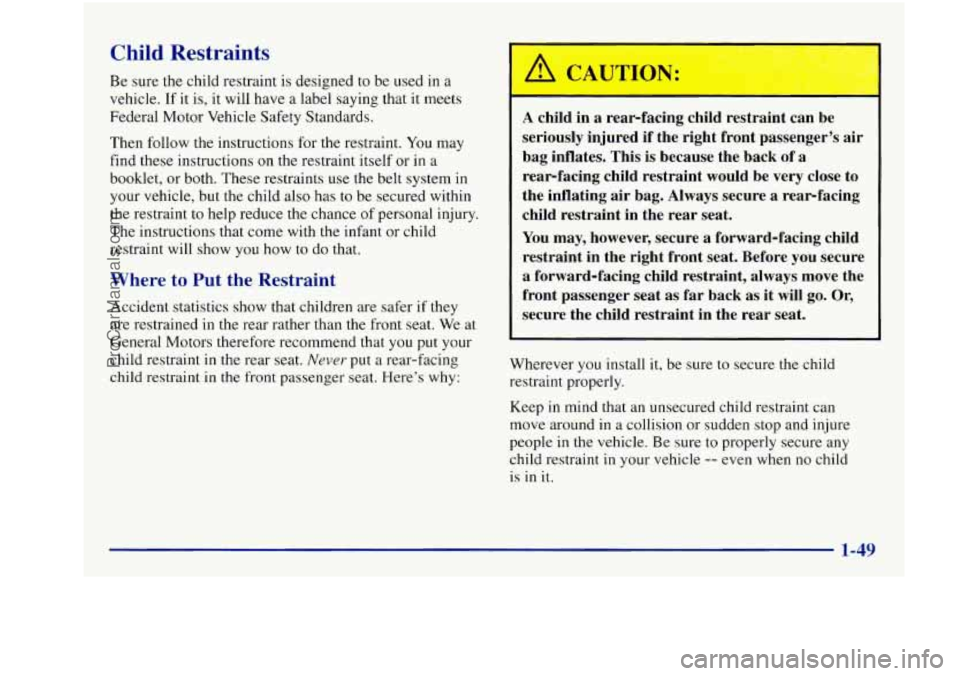
Child Restraints
Be sure the child restraint is designed to be used in a
vehicle. If it is, it will have a label saying that
it meets
Federal Motor Vehicle Safety Standards.
Then follow the instructions for the restraint. You may
find these instructions on the restraint itself or in a
booklet, or both. These restraints
use the belt system in
your vehicle, but the child also has to be secured within
the restraint to help reduce the chance of personal injury.
The instructions that come with the infant or child
restraint will show you how to do that.
Where to Put the Restraint
Accident statistics show that children are safer if they
are restrained in the rear rather than
the front seat. We at
General Motors therefore recommend that you put your
child restraint in the rear seat.
Never put a rear-facing
child restraint in
the front passenger seat. Here’s why:
A child in a rear-facing child restraint can be
seriously injured
if the right front passenger’s air
bag inflates. This
is because the back of a
rearfacing child restraint would be very close to
the inflating
air bag. Always secure a rear-facing
child restraint in the rear seat.
You may, however, secure a forward-facing child
restraint in the right front seat. Before you secure
a forward-facing child restraint, always move the
front passenger seat as
far back as it will go. Or,
secure the child restraint in the rear seat.
Wherever you install it, be sure to secure the child
restraint properly.
Keep
in mind that an unsecured child restraint can
move around in
a collision or sudden stop and injure
people in the vehicle. Be sure to properly secure any
child restraint
in your vehicle -- even when no child
is
in it.
ProCarManuals.com